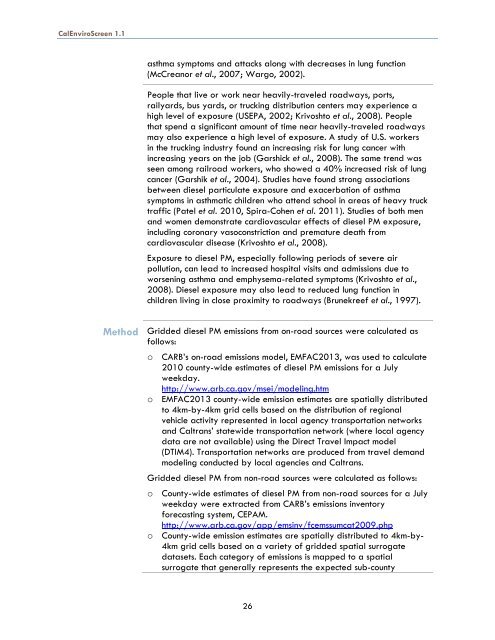CalEnviroscreen Version 1.1 - OEHHA - State of California
CalEnviroscreen Version 1.1 - OEHHA - State of California
CalEnviroscreen Version 1.1 - OEHHA - State of California
You also want an ePaper? Increase the reach of your titles
YUMPU automatically turns print PDFs into web optimized ePapers that Google loves.
CalEnviroScreen <strong>1.1</strong><br />
asthma symptoms and attacks along with decreases in lung function<br />
(McCreanor et al., 2007; Wargo, 2002).<br />
People that live or work near heavily-traveled roadways, ports,<br />
railyards, bus yards, or trucking distribution centers may experience a<br />
high level <strong>of</strong> exposure (USEPA, 2002; Krivoshto et al., 2008). People<br />
that spend a significant amount <strong>of</strong> time near heavily-traveled roadways<br />
may also experience a high level <strong>of</strong> exposure. A study <strong>of</strong> U.S. workers<br />
in the trucking industry found an increasing risk for lung cancer with<br />
increasing years on the job (Garshick et al., 2008). The same trend was<br />
seen among railroad workers, who showed a 40% increased risk <strong>of</strong> lung<br />
cancer (Garshik et al., 2004). Studies have found strong associations<br />
between diesel particulate exposure and exacerbation <strong>of</strong> asthma<br />
symptoms in asthmatic children who attend school in areas <strong>of</strong> heavy truck<br />
traffic (Patel et al. 2010, Spira-Cohen et al. 2011). Studies <strong>of</strong> both men<br />
and women demonstrate cardiovascular effects <strong>of</strong> diesel PM exposure,<br />
including coronary vasoconstriction and premature death from<br />
cardiovascular disease (Krivoshto et al., 2008).<br />
Exposure to diesel PM, especially following periods <strong>of</strong> severe air<br />
pollution, can lead to increased hospital visits and admissions due to<br />
worsening asthma and emphysema-related symptoms (Krivoshto et al.,<br />
2008). Diesel exposure may also lead to reduced lung function in<br />
children living in close proximity to roadways (Brunekreef et al., 1997).<br />
Method Gridded diesel PM emissions from on-road sources were calculated as<br />
follows:<br />
o CARB’s on-road emissions model, EMFAC2013, was used to calculate<br />
2010 county-wide estimates <strong>of</strong> diesel PM emissions for a July<br />
weekday.<br />
http://www.arb.ca.gov/msei/modeling.htm<br />
o EMFAC2013 county-wide emission estimates are spatially distributed<br />
to 4km-by-4km grid cells based on the distribution <strong>of</strong> regional<br />
vehicle activity represented in local agency transportation networks<br />
and Caltrans’ statewide transportation network (where local agency<br />
data are not available) using the Direct Travel Impact model<br />
(DTIM4). Transportation networks are produced from travel demand<br />
modeling conducted by local agencies and Caltrans.<br />
Gridded diesel PM from non-road sources were calculated as follows:<br />
o County-wide estimates <strong>of</strong> diesel PM from non-road sources for a July<br />
weekday were extracted from CARB’s emissions inventory<br />
forecasting system, CEPAM.<br />
http://www.arb.ca.gov/app/emsinv/fcemssumcat2009.php<br />
o County-wide emission estimates are spatially distributed to 4km-by-<br />
4km grid cells based on a variety <strong>of</strong> gridded spatial surrogate<br />
datasets. Each category <strong>of</strong> emissions is mapped to a spatial<br />
surrogate that generally represents the expected sub-county<br />
26















